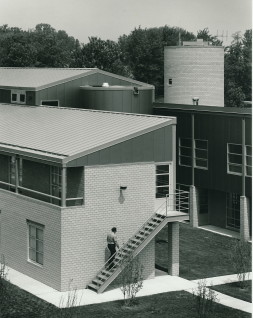TRUE STEEL
I always found the I- beam profiles Mies Van der Rohe applied in front of the hidden and fireproofed structural columns in his Chicago towers profoundly disturbing, because they blatantly contradicted his professed belief in structural truth. The best reason he could offer for their use was “We looked at it on the model without the steel section [I-beams] attached to the corner columns and it did not look right.” * If anything goes when it has to look right, why then insist on the ethical and esthetic superiority of “structural truth”? When I designed Fire Station Five in Columbus IN I had the opportunity to confront the same problem, which I resolved to address without resorting to esthetic lies. The Fire Station is a steel frame masonry-clad building. It has a courtyard defined by steel panel walls that evoked the metal sheds of earlier fire stations. To express the steel structure on the masonry façades was easy, because the steel columns emerged without the code-mandated fireproofing from the masonry walls into the upper floor loggias to support the roof. In the courtyard the galleries are on the ground level, providing cover from the parking to the building’s entrances. The problem was how to show the columns holding the roof if they disappeared within the upper story wall. The application of I-beams to the façade was suggested – if Mies could do it, who was I to reject this solution? I reasoned that making the columns external to the wall would make fireproofing unnecessary. But a partner in the “nuts and bolts” firm that collaborated with me in the project’s implementation thought the idea was impractical, if not downright eccentric.
I was lucky to have the help of Anna Zietsma who, close to her retirement, no longer minded subverting her boss’ attempt to sabotage my idea. Anna believed in structural honesty and gave as much importance to the details of building as I did. And she had over two decades of experience more than I did. So, together, we managed to design a detail that affirmed the beauty and poetry of structural truth. Anna was the perfect “forgotten woman”, indispensable yet never promoted or rewarded for the excellence of her work.
I recently discovered that Anna Zietsma had died in 1998, and that her sister in Holland had only then learned about the daughter Anna had given into adoption at age 38, unmarried and alone. This story is also for that daughter.
* “Mies van der Rohe’s New Buildings”, Architectural Forum 97 (November 1952): p. 99
reply? please send me an e-mail
